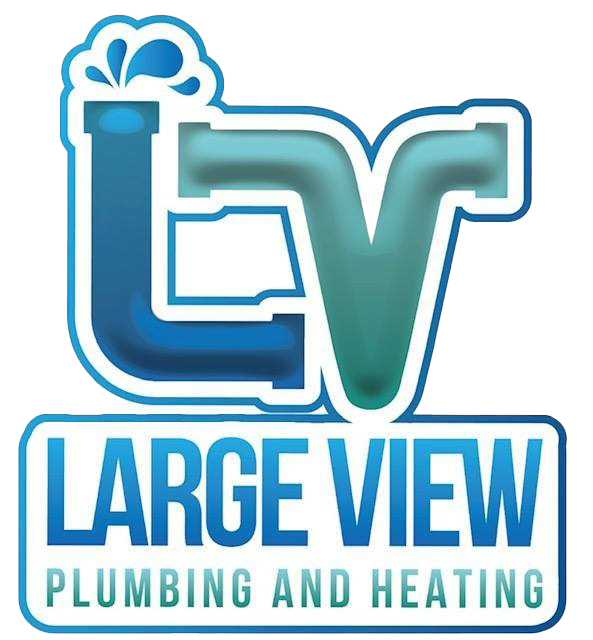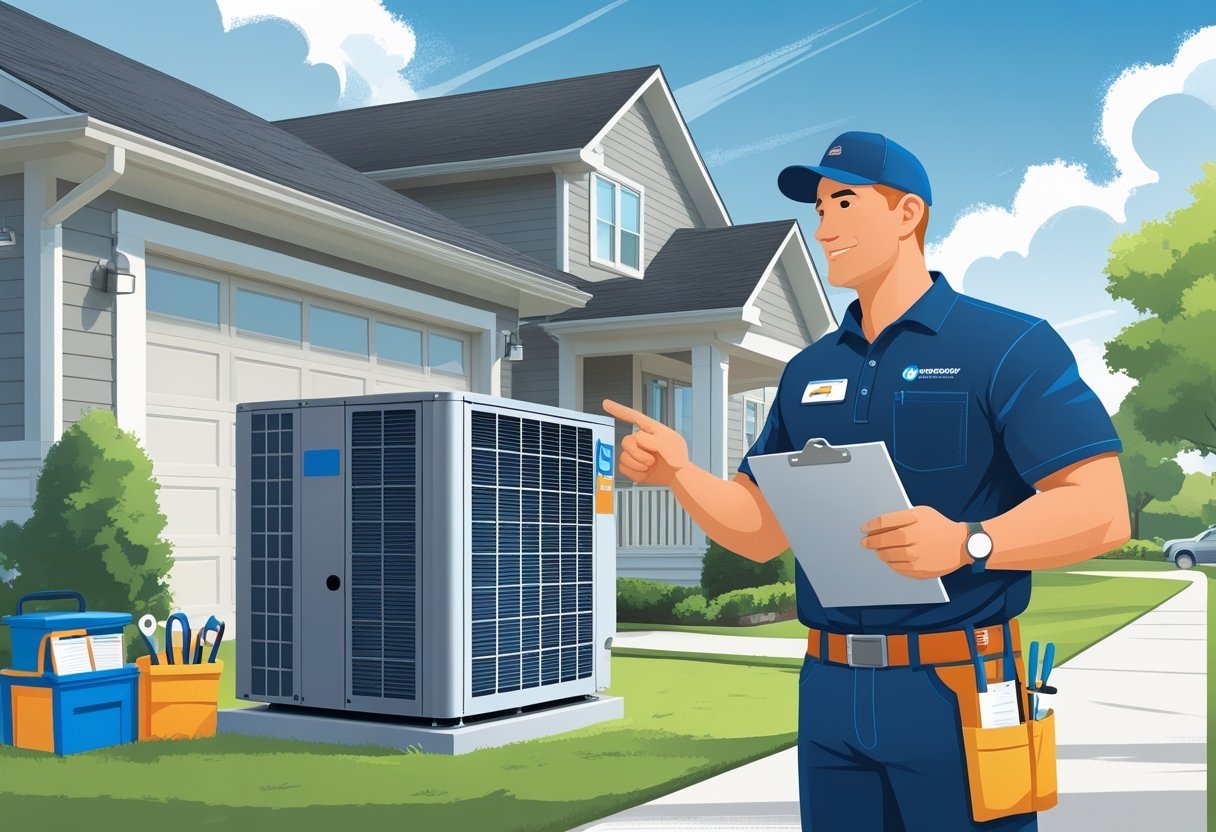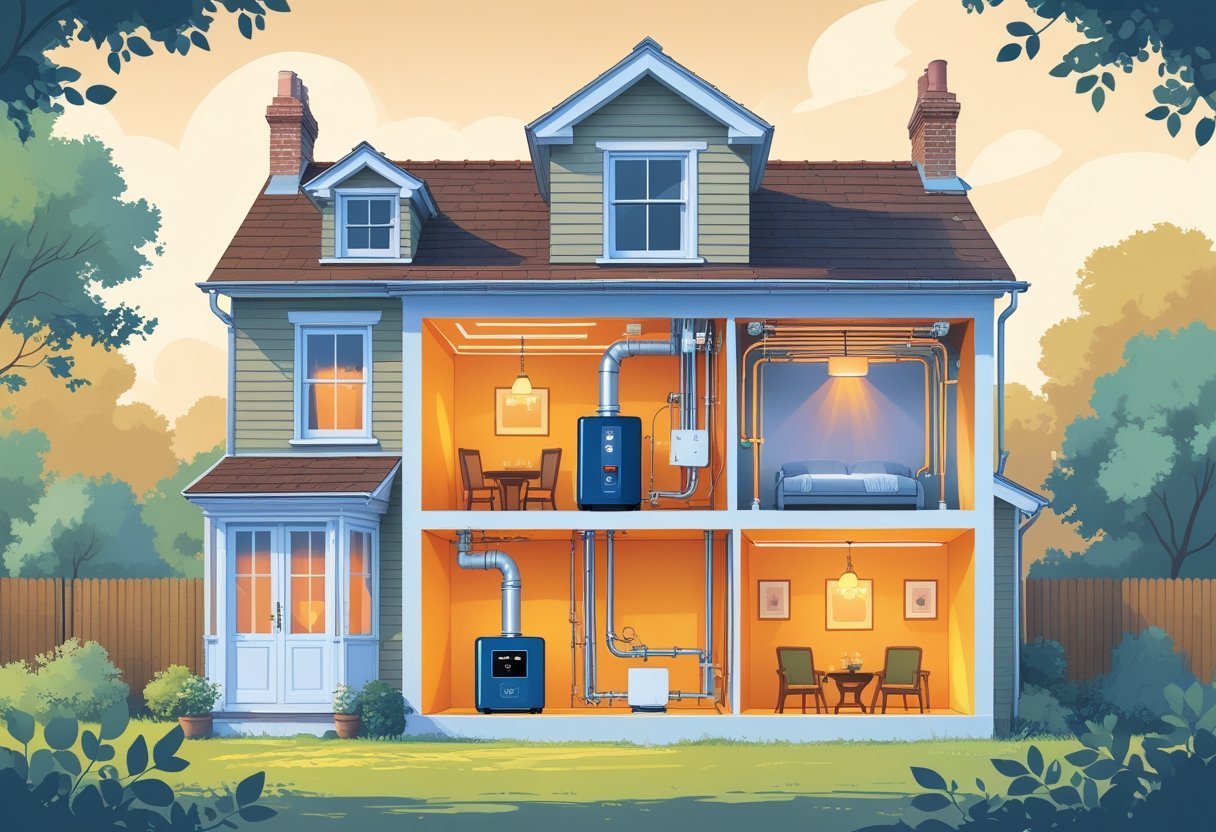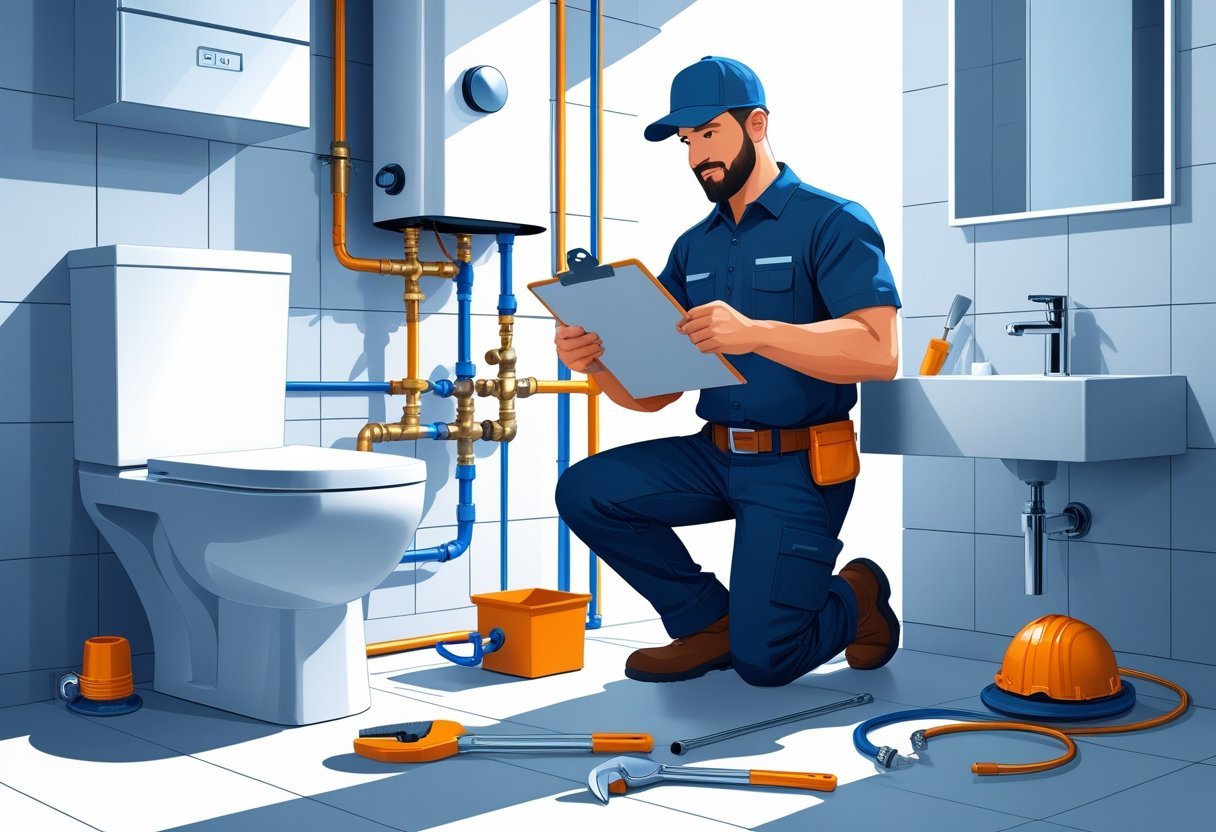If you’re considering radiant floor heating for your home, it’s important to understand both the benefits and potential drawbacks of this underfloor heating system. Radiant floor heating provides consistent, energy-efficient warmth that enhances comfort by heating your space from the ground up. This feature makes it especially appealing for cold climates or rooms with tile or stone flooring.
However, it’s not without challenges. Installation can be costly and somewhat disruptive, especially if retrofitting an existing home. Maintenance tends to be minimal, but repairs can be more complicated compared to traditional heating systems.
When working with a trusted team like Large View Plumbing & Heating, you can get expert advice tailored to your home’s needs. Their decade of experience ensures that your radiant heating system is installed or serviced with precision and care, helping you decide if this solution fits your comfort and budget goals.
How Radiant Floor Heating Works
Radiant floor heating systems warm your living space by directly heating the floor surface, which then transfers heat evenly throughout the room. These systems employ different types of heat sources and mechanisms but share the goal of delivering consistent, comfortable warmth.
Heating Mechanism
Radiant floor heating works mainly through two systems: hydronic and electric. Hydronic radiant floor heating uses a boiler or heat pump to heat water, which is then circulated through plastic tubing embedded under the floor. This heated water radiates warmth upward, heating the floor and surrounding air.
Electric radiant heating operates with electric cables or mats installed under the floor surface. When powered, these cables generate heat directly, warming the floor quickly and efficiently. Both systems focus heat at the floor level rather than warming air that can quickly dissipate, making them energy-efficient options.
Heat Distribution Process
Once the floor surface is heated, it radiates heat evenly into the room, creating a comfortable and stable temperature. Unlike forced-air systems that rely on convection, radiant heating warms objects and occupants directly.
This heat distribution is gradual but steady. The floor’s thermal mass retains warmth and releases it evenly, reducing cold spots and drafts. Hydronic systems may take longer to heat up initially compared to electric models, but they often maintain heat longer and are suitable for larger spaces.
Both systems work with a range of flooring materials, though some options like tile transfer heat more effectively than carpet. Consider these details carefully to maximize the performance of your radiant heating system. For expert installation and service in North Shore, Massachusetts, Large View Plumbing & Heating can ensure your system operates reliably and efficiently.
Key Advantages of Radiant Floor Heating
Radiant floor heating provides a consistent warmth that spreads evenly across your living space, reducing cold spots and enhancing comfort. This system also offers notable energy savings, cutting down consumption compared to traditional heating methods. Additionally, it works quietly and improves indoor air quality, making your home both peaceful and healthier.
Even and Comfortable Heat
With radiant floor heating, heat is distributed evenly from the floor up, preventing the uneven temperature zones common with forced-air systems. This means your feet stay warm while the rest of the room reaches a comfortable temperature without overheating.
Since it heats surfaces directly, radiant systems eliminate cold drafts and the need for bulky radiators or vents. This creates a more pleasant environment, especially in rooms with tile or hardwood floors. The steady, gentle heat feels natural and reduces the chill often felt near windows or doors.
Energy Efficiency and Consumption
Radiant floor heating can reduce your energy consumption by up to 30% compared to forced-air systems, according to several studies. Its efficiency comes from heating your space more directly, so your thermostat can be set lower while maintaining comfort.
Because the system operates at lower temperatures, it puts less strain on your heat source, whether it’s a boiler or heat pump. This results in lower utility bills and decreased wear on your heating equipment. If you use a professional service like Large View Plumbing & Heating in North Shore, Massachusetts, you can ensure installations maximize these efficiency benefits.
Silent Operation and Air Quality
Unlike forced-air heating, radiant floors operate in complete silence. You won’t hear fans or blowers running, which creates a quieter, more relaxing atmosphere in your home.
Since the system doesn’t blow air around, it minimizes the circulation of dust, allergens, and pollutants. This improves indoor air quality and benefits anyone with respiratory sensitivities or allergies. Plus, the low maintenance requirements of radiant floor heating mean fewer disruptions and lasting performance when installed by experienced professionals like Large View Plumbing & Heating.
Potential Drawbacks to Consider
Radiant floor heating comes with specific challenges that can affect your budget, time, and material choices. These include upfront investment, potential difficulties in upkeep, and the compatibility of your flooring materials. Knowing these details can help you prepare for what to expect.
Installation Costs and Complexity
Installing radiant floor heating typically involves a higher upfront cost compared to traditional heating systems. The process requires professional expertise to embed heating elements beneath the floor, which can include electric mats or water-based tubing. This complexity often means longer installation times and higher labor fees.
You might face additional expenses if your existing floor needs to be removed or altered. Because of the technical demands, companies like Large View Plumbing & Heating, which specialize in plumbing and heating in North Shore, Massachusetts, are preferred for proper installation. Improper setup can lead to inefficiencies or costly repairs later.
Planning your project carefully with a professional ensures you account for all costs, from materials to labor, avoiding surprises during the build.
Maintenance and Repair Difficulties
Radiant floor heating systems generally require less day-to-day maintenance than forced-air systems, but when problems occur, they can be more complicated to fix. Since the heating components are embedded under the flooring, detecting and repairing leaks or faults can involve dismantling part of your floor, increasing repair costs and time.
Routine maintenance involves checking system pressure and ensuring boilers or pumps are functioning well. It’s advisable to schedule inspections with experienced technicians who understand the system intricacies. Large View Plumbing & Heating can help provide ongoing support to prevent issues before they become serious.
You should budget for occasional maintenance and possible repairs, particularly if your system uses hydronic tubing, which is prone to leaks or corrosion over many years.
Floor Covering Compatibility
Not all floor types work equally well with radiant heating. Materials like tile, stone, and certain laminates transfer heat efficiently and maintain warmth. Carpets, thick wood floors, or some vinyl options, however, can insulate against heat, reducing system effectiveness.
If you plan to install radiant heating, consider your current and future floor coverings. You may need to avoid thick rugs or insulating materials on top of the heated floors. Some flooring manufacturers provide guidelines on which products best pair with radiant heat.
Choosing compatible materials ensures you get consistent warmth and protects your investment in the heating system. Make this an important factor when planning your installation.
Types of Radiant Floor Heating Systems
Radiant floor heating primarily comes in two forms, each with unique features and installation requirements. You will want to understand their distinct methods of heat delivery, costs, and maintenance needs to choose the right fit for your home.
Hydronic Floor Heating Systems
Hydronic radiant floor heating uses warm water circulated through a network of flexible PEX tubing embedded beneath your floors. The water is heated by a boiler, which can run on gas, oil, or electricity. This system is highly efficient for heating large areas and is often more cost-effective during long heating seasons.
You control the water temperature and flow with a manifold, allowing precise zoning for different rooms. Maintenance involves boiler servicing and occasional tube inspections, which can be handled easily if installed by trusted professionals like Large View Plumbing & Heating. Hydronic systems require more upfront installation effort because of plumbing work, but they provide consistent warmth and lower operating costs over time.
Electric Radiant Floor Heating Systems
Electric radiant floor heating involves electric cables or mats placed under the floor surface. These systems heat up quickly and are generally easier and less expensive to install, especially in smaller areas or retrofit projects. You will find electric radiant heating ideal for bathrooms, kitchens, or spot heating.
The system works by running electric current through resistance wires, generating heat evenly across the floor. However, the operating cost tends to be higher compared to hydronic setups, especially in colder climates. Maintenance is minimal due to few moving parts, but any repair requires accessing the floor, which can be disruptive. Large View Plumbing & Heating can help you evaluate whether electric radiant heating suits your specific needs and budget.
Installation and Design Considerations
Proper installation and thoughtful design significantly impact the performance and costs of radiant floor heating. Decisions about who installs the system and how you manage heat distribution can affect both upfront expenses and long-term comfort.
Professional vs DIY Installation
Radiant floor heating installation involves complex plumbing or electrical work depending on the system type. While DIY options may appeal to reduce costs, professional installation ensures system sizing is accurate, avoiding uneven heating and inefficiency.
Professionals like Large View Plumbing & Heating bring experience that minimizes installation errors, preventing costly repairs later. Licensed installers also comply with building codes and handle necessary permits, which can be overlooked in DIY projects.
Installation costs vary based on system complexity and flooring type, with hydronic systems generally requiring higher upfront investment than electric. Labor makes up a significant portion of the total cost, so professional help can provide value that outweighs initial savings.
Zoned Heating and Controls
Zoned heating divides your home into sections with individual temperature controls, improving comfort and energy efficiency. You can heat only occupied areas, lowering energy consumption and extending equipment life.
Implementing zones requires thoughtful layout planning during installation to ensure proper system sizing for each zone. Controls can range from simple thermostats to advanced smart systems that adapt heating schedules based on occupancy or time of day.
Choosing the right zoning and control options allows more precise temperature management and can lower bills. Working with experienced installers ensures your system supports zoning effectively and fits your home’s specific heating needs.
Additional Applications and Future Trends
Radiant floor heating technology is evolving beyond traditional heating. New applications aim to expand comfort solutions and improve energy efficiency. Integration with modern systems is enhancing control and responsiveness, making these systems smarter and more versatile.
Radiant Cooling
Radiant cooling operates on the same principle as radiant heating but removes heat from floors or ceilings to cool a space. This method avoids blowing air, reducing noise, dust circulation, and uneven temperatures often found with traditional air conditioning.
Radiant cooling systems work best in climates or buildings where humidity is controlled, as condensation on cold surfaces can be a concern. It offers consistent, silent cooling and can be more energy-efficient when combined with dehumidification.
If you are considering installation or an upgrade, Large View Plumbing & Heating in North Shore, Massachusetts, can help assess whether radiant cooling fits your building’s needs. Their team applies modern solutions to optimize both heating and cooling for balanced indoor comfort.
Integration with Smart Home Systems
Smart home technology enables you to monitor and adjust radiant floor heating remotely. You can schedule temperature changes, track energy usage, and maintain comfort efficiently through smartphone apps or voice control.
This integration allows for adaptive heating, where sensors adjust floor temperature based on your presence or weather forecasts. It reduces energy waste and can lower utility costs.
When planning radiant heating installation or upgrades, ask your certified professionals about smart system compatibility. Large View Plumbing & Heating offers expertise to integrate radiant systems with your home’s automation, ensuring reliable, user-friendly control with personalized settings.
Frequently Asked Questions
Radiant floor heating offers different system types, installation options, and maintenance needs that can affect your experience. Factors such as energy efficiency, cost, and impact on indoor air quality vary depending on your setup and location.
What are the energy efficiency differences between electric and hydronic radiant floor systems?
Electric radiant floor heating tends to have a quicker response time but can be more expensive to operate long-term. Hydronic systems use heated water and generally offer better efficiency for larger spaces, especially when paired with high-efficiency boilers or heat pumps.
Can radiant floor heating be installed under any type of flooring?
Radiant heating works best under tile, stone, or concrete floors because they conduct heat well. It can be installed under hardwood or laminate, but you need to ensure the flooring material can tolerate the heat and that the installation is done carefully to avoid damage.
How does radiant floor heating impact indoor air quality compared to traditional heating systems?
Radiant floor heating does not rely on air circulation, so it does not stir up dust or allergens. This often results in better indoor air quality than forced-air systems, which can circulate allergens and dry out the air.
What is the longevity and maintenance required for radiant floor heating systems?
Hydronic systems typically last 25 years or more with proper maintenance, while electric systems may last 20 years or more. Routine checks, such as inspecting the boiler or electrical components, can prevent issues. Large View Plumbing & Heating stresses the importance of professional maintenance to keep your system operating efficiently.
How do installation costs for radiant floor heating compare with conventional heating solutions?
Installation costs for radiant floor heating are generally higher than for forced-air or baseboard systems. Hydronic systems require more materials and labor, raising upfront investment. However, the improved comfort and energy savings may offset initial expenses over time.
Are there specific considerations for implementing radiant floor heating in various climates?
In colder climates, radiant floor heating can provide consistent warmth with less energy loss. For mild or warm climates, it might be less cost-effective unless used as supplemental heat. Local expertise, such as that from Large View Plumbing & Heating in North Shore, Massachusetts, can guide optimal system choices based on your regional climate.






